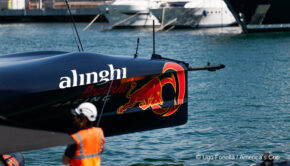Explaining the Challenger of Record Concept
Published on July 30th, 2014
Interest in the America’s Cup grew rapidly during the 1960’s, with multiple foreign clubs expressing their desire to challenge. A casual agreement on who might challenge, and in what order, was adopted but proved to be awkward in practice, so when multiple challenges were received for 1970, rather than select one yacht club to compete as challenger in the match, by mutual agreement it was established that several prospective challenger candidates could compete against each other for the right to sail in the America’s Cup match against the Defender.
This was the first time that candidates from multiple countries vied against each other on the water for the chance to challenge. It was hoped that having several challenger candidate race in a competitive selection process would help improve challenger performance, much as the New York YC’s standard practice of defender trials had done historically.
The Challenger of Record (COR) arrangement, as it has come to be termed, allows one foreign YC to challenge (becoming the initial COR), that Club agreeing to the terms of the match with the defender and subsequently allowing the winner of the challenger selection series to step into the place of the COR. Prior to 1983, the challengers conducted the challenger selection regatta under their own management and at their own cost. Starting in 1983, Louis Vuitton sponsored the challenger selection, awarding the Louis Vuitton Cup to the ultimately selected challenger. Technically, the eventual winner of the challenger selection process becomes the final Challenger of Record, and win or lose in the match, goes down in history as the Challenger for that America’s Cup match.
Since 1970 there have been 13 matches with multiple challengers, with 12 teams serving as the initial COR. Including the upcoming 35th Defense of the America’s Cup scheduled for 2017, the initial COR has resigned four times; three times also withdrawing from competition (1974, 2013, and 2017); one time remaining a competitor (1992).
This report, assembled by CupInfo.com, provides a complete explanation for what occurred in each America’s Cup from 1970 to 2017. Click here read on.









 We’ll keep your information safe.
We’ll keep your information safe.